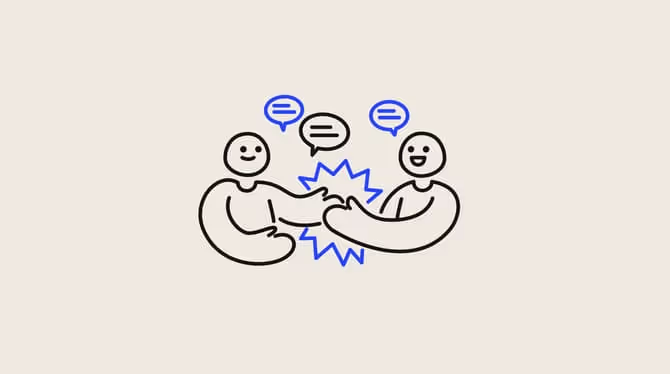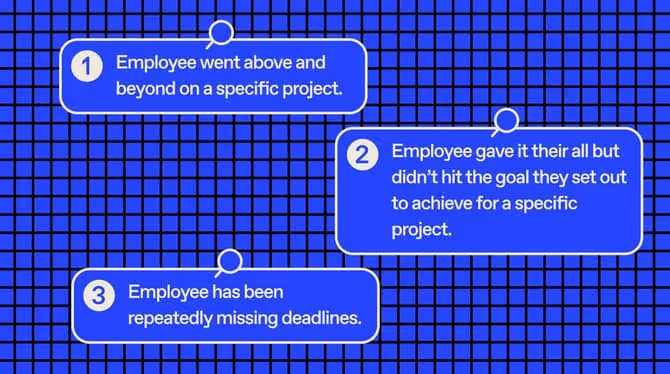Employee feedback that drives results: 10 tips for effective delivery

Discover Workleap Officevibe's benchmark report on 12 key employee engagement metrics

Picture this scenario: It's the third time you've given the same feedback to an employee about a recurrent problem (say, about a missed deadline or lack of communication on a critical task) and you're running out of new ways to express constructive criticism. Sounds familiar? Everyone deserves a fair chance at gradually improving their performance, but managers don't want to sound like broken records either.
So what's the solution, here? While employees are accountable for the outcomes of their performance, it's a manager's responsibility to deliver employee feedback in a clear and effective way. Done right, even the most negative feedback can churn out positive outcomes.
Managers shouldn't shy away from feedback — employees crave it. In fact, almost a third of employees report wanting more regular feedback from their direct supervisors and peers.
Consider this article a manager's handbook to employee feedback delivery — the fundamentals of effective feedback, practical tips on providing employee feedback, and constructive employee feedback examples to help tailor your own.
What is employee feedback?
Before we discuss the theory, let's ensure we understand what effective employee feedback is and why it matters.
Employee feedback is a core part of continuous performance management and is key to organizational growth. Feedback conversations communicate observations and assessments about an employee's performance, along with recommendations by managers on the way forward. Thanks to feedback, employees have a better sense of direction in their work to enhance their performance.
Employee feedback is a valuable tool for professional development, recognizing strengths as much as areas for improvement. There are different types of feedback, from positive reinforcement to constructive feedback.
Types of employee feedback
There are many approaches managers can take when it comes to providing feedback to their teams. Whether it's positive feedback, negative feedback, or constructive criticism — each has its purpose. By understanding the nuances and benefits of the different types of employee feedback available, managers can tailor conversations and action plans to individual needs.
Ultimately, effective feedback is all about empowering employees and providing them with the right information on their performance so they can improve. It should be clear, supportive, and motivating.
Positive feedback
Positive employee feedback (often referred to as praise or recognition) is all about acknowledging what's going well to reinforce good behaviors or performance outcomes. Providing positive feedback is generally the easiest for managers to do!
Some positive employee feedback examples:
- An employee has demonstrated exceptional initiative and problem-solving skills on a recent project, and you tell them that you recognize and value this during an in-person chat.
- Your team pooled great effort to deliver a project ahead of schedule, and you tell them at the next team meeting what a good job they've done.
{emphasize}Pro tip: Going the extra mile on positive feedback
There are many ways to deliver positive feedback. It can be via verbal praise alone, but on certain occasions (when managers really want to make a statement), complementing the praise with a reward like a sweet treat or a half-day off incentivizes employees to keep excelling.{emphasize}
Negative feedback
Negative employee feedback is much less pleasant to deliver (or receive) than positive feedback. The goal of negative feedback, though, is to address areas of concern or performance gaps that require the employee's attention and improvement.
Negative employee feedback examples
- An employee has been consistently late to meetings and you address how this is impacting team productivity.
- A project delivered did not meet the company's quality standards and you provided this feedback to the team members involved.
{emphasize}Honestly? We don't recommend straight-up negative feedback.
While negative feedback is necessary at times, it's important to approach tough chats with sensitivity and empathy — which is why formulating negative feedback as constructive feedback instead is more effective. Jump to the next bit.{emphasize}
Constructive feedback
Constructive feedback can be viewed as a cross between positive and negative employee feedback. It combines highlighting areas of strength (positive reinforcement) while underlining what needs improvement (what's not great) in a supportive, solution-oriented manner.
Constructive employee feedback examples
- You acknowledge an employee's strong communication skills while simultaneously suggesting ways they can work on their active listening skills.
- You underline the challenges with your team meeting their deadlines while providing specific recommendations to help with time management.
{emphasize}Pro tip: How about the sandwich method?
The sandwich method is a tried-and-tested approach to providing constructive feedback — and a winner in our books. The gist of it is that it "sandwiches" constructive criticism between two positives. This way, feedback conversations start and end on a good note.{emphasize}
Continuous feedback
Continuous feedback is less a feedback type and more a framework where ongoing communication and dialogue are emphasized and central to success. It moves away from traditional feedback methods (like once-a-year performance reviews) and encourages real-time feedback and coaching.
Continuous employee feedback examples
- You regularly check in with employees to discuss progress, and challenges, and make sure goals remain aligned — be it at a scheduled one-on-one or unplanned around the coffee machine
- You provide feedback immediately after a task or project is completed, focusing on specific actions or outcomes, to inform an employee's performance on the next task or future projects.
{emphasize}Pro tip: Commit to the cycle with follow-ups
The best way to ensure you're engaging employees in a continuous feedback flow is to make a habit of scheduling follow-ups on action items stemming from feedback. This feeds the cycle: provide constructive feedback, set action items, and check back in on how everything is going.{emphasize}
10 tips for delivering effective employee feedback
Providing constructive feedback is essential for employee growth and development. However, delivering feedback effectively requires finesse and tact.
Here are ten tips to help you navigate the feedback process with confidence and clarity:
Tip #1: Set clear goals and expectations
Managers should clearly define expectations and objectives around performance to provide a framework and point of reference for feedback. Clarity helps employees understand what is exactly expected of them. It also helps everyone have more targeted and relevant feedback discussions.
{highlight}For example, if you're providing feedback on a project, outline specific goals, deadlines for each task, and desired outcomes at the outset — which you'll be able to reference back to at the end.{highlight}
Tip #2: Catch the momentum and be timely
Don't miss the window! By delivering feedback in a timely manner, managers can tackle issues with employees as they arise. This provides opportunities for immediate course correction rather than waiting too long for a problem to fester. Timely positive feedback also shows employees that their hard work doesn't go unnoticed.
{highlight}For instance, if you notice a team member struggling with a particular task, address it at the next available opportunity (be it a last-minute meeting or a quick phone call) rather than waiting for a formal review meeting.{highlight}
Tip #3: Focus on behavior, not intentions
Managers should focus on specific behaviors or actions rather than making generalizations or assumptions about the employee. Keeping feedback conversations objective and based on facts avoids turning things into a personal issue and helps employees understand the actionable steps they can take to improve performance.
{highlight}Instead of saying, "You're not a team player," focus on specific instances where collaborative efforts could be improved. This sounds like "When you don't let other team members speak, it takes away from opportunities where we can learn from each other."{highlight}
Tip #4: Be as specific as possible — and use examples
Providing specific examples and evidence to support feedback makes a stronger case for what needs improvement in the eyes of the employee in question. It's about giving context to the feedback, answering not just the "what" but the "why".
{highlight}Instead of saying, "Your presentation was unclear," provide specific examples of where the message could be strengthened, such as "Your presentation could've benefited from organizing the content more logically or using visual aids effectively."{highlight}
Tip #5: Apply a growth mindset
Approaching feedback from a growth mindset perspective means emphasizing the opportunities it presents for learning and development. Encouraging employees to see setbacks as opportunities for growth and resilience-building will avoid deflating motivation and remind them of the bigger picture.
{highlight}Frame every feedback constructively, regardless if it's positive or negative, and connect the next steps to overarching professional development opportunities.{highlight}
Tip #6: Foster open communication between all parties
Managers have to create a safe and supportive environment for feedback where employees feel comfortable sharing their perspectives and concerns. This fosters trust and transparency within the team and is essential for building feedback loops.
{highlight}Encourage open dialogue by actively listening to employee feedback and responding with empathy and respect. Make sure there's always time for everyone to express themselves — otherwise, feedback becomes one-sided.{highlight}
Tip #7: Solicit feedback from everyone
Feedback doesn't just have to come from managers. By inviting employees to provide feedback on their own performance and the feedback process itself, managers can improve their strategies too. This collaborative approach empowers employees to take ownership of their development and builds mutual respect.
{highlight}Actively seek input from employees on how they prefer to receive feedback and what support they need to succeed. A pulse survey is a great way to automate that work for you!{highlight}
Tip #8: Offer support to develop action plans
Accompanying feedback should be the necessary resources, training, or mentoring to help employees address areas for improvement identified in the feedback. This demonstrates a manager's commitment to supporting employee growth.
{highlight}For example, if an employee struggles with time management, offer time management workshops or one-on-one coaching sessions to develop skills and strategies.{highlight}
Tip #9: Follow up, always
Following up on feedback discussions is part of progress monitoring. Regularly checking in also enables managers to offer additional support when needed and recognize efforts and achievements along the way.
{highlight}Check-in regularly with employees to see how they're implementing feedback via a quick Slack message. A weekly or daily reminder will ensure this doesn't slip through the cracks!{highlight}
Tip #10: Lead by example
Managers can model the behavior they wish to see in their teams by actively seeking and responding to feedback from their own managers and colleagues. This sets a positive example for others and reinforces the importance of continuous improvement at every level.
{highlight}Demonstrate a willingness to learn and grow by soliciting input on your own performance and incorporating feedback into your professional development plans.{highlight}
Effective feedback is a two-way street that requires clear communication, empathy, and a commitment to ongoing development from everyone. By incorporating these tips into their feedback approach, managers help cultivate a company culture of constant growth and learning.
4 innovative feedback methods
Traditional forms of feedback aside, managers can leverage more innovative approaches to enhance feedback — making the process more engaging and impactful for everyone involved.
Here are some new ways companies are experimenting to deliver feedback more effectively:
- Gamification: Incorporating elements of gamification adds a fun and interactive dimension to the feedback process. Today, there exist many gamified performance management platforms that enable employees to receive feedback in the form of badges, points, or rewards for achieving milestones or accomplishing tasks. Not only does gamification make feedback a dynamic aspect of the employee experience, but it encourages healthy competition at work too.
- Video feedback sessions: Instead of relying solely on written or verbal feedback, companies are now embracing video feedback sessions — something that has become a necessity for remote teams. Video feedback sessions can be live, which is ideal to engage in dialogue, but managers can also record personalized video messages ahead of time. Video offers a more dynamic and expressive communication medium, conveying tone and body language much better than an email, which allows for more clarity and empathy.
- Peer feedback exchanges: Feedback doesn't just have to come from managers. Peer-to-peer feedback provides employees with the opportunity to receive insights and perspectives from their colleagues. Sometimes, feedback might resonate that much more when it comes from someone who does the same job we do. Facilitating structured feedback sessions between peers also signals that a company fosters an internal feedback culture based on mutual support and learning.
- Real-time feedback apps: Real-time feedback apps are gaining popularity across the globe as tools for continuous performance management. These apps enable employees to request and receive feedback from managers or peers instantly, on their phones or laptops, which engages everyone in timely, actionable conversations. Real-time feedback apps are key to building continuous feedback loops, as well as promoting agility and responsiveness in addressing issues.
Of course, nothing beats a high-five and great feedback doesn't have to be complicated. That said, we encourage managers and employees alike to inject a bit of creativity and dynamism into the entire feedback experience to keep employee engagement levels high.
Applying the SCARF model: The psychology behind feedback
Why does effective feedback require such involved consideration? For one, feedback is perceived as a social threat by our brains. This triggers self-protective mechanisms to preserve our self-esteem — hence why some employees get defensive when receiving feedback.
Managers can deliver feedback more effectively by understanding the psychology behind it. David Rock, the author of "Your Brain At Work" and pioneer of neuroleadership, created the SCARF model to explain the social threats our brains perceive.
{emphasize}
Status
Status refers to a person's position relative to others — and any criticism that threatens someone's status can evoke feelings of defensiveness. To mitigate this, managers should encourage employees to self-reflect by asking questions like, "How do you think that went? Is there anything you believe you could improve on for next time?"
{emphasize}
{emphasize}
Certainty
Uncertainty about the future (especially regarding job security) can intensify the perceived threat of feedback. By providing clear goals and reaffirming objectives during feedback sessions, managers can help employees feel more certain and secure that there are solutions and a way forward.
{emphasize}
{emphasize}
Autonomy
Employees do need support, but they also value autonomy and feeling a sense of self-reliance. Feedback can be perceived as micromanaging and suffocating. When delivering feedback, managers should involve employees in the decision-making process of setting the next steps and new goals to maintain their sense of control and independence.
{emphasize}
{emphasize}
Relatedness
The quality of the relationship between the feedback giver and the feedback receiver can influence the way feedback is received. Feedback that feels demeaning or isolating can trigger defensive reactions. That's why managers need to establish a personal connection with each of their staff to foster a supportive environment.
{emphasize}
{emphasize}
Fairness
Employees compare themselves to their peers — that's an unavoidable reality. If unfairness is perceived, like an employee feeling singled out, this can exacerbate defensiveness. Managers should ensure feedback is equitable and transparent, and emphasize that all team members receive similar levels of feedback.
{emphasize}
Master the art of giving employee feedback
Effective employee feedback delivery is an essential skill to hone — and key in driving employee engagement, performance, and success. By mastering the art of giving feedback, you, too, can empower your teams to reach their full potential.
Interested in a deeper dive into employee feedback? Check out our Employee Feedback Demystified: A Comprehensive Guide for Managers for actionable insights and practical tips to elevate your feedback game.
With the right approach and mindset (and a few practical tips), any manager can turn stressful feedback discussions into powerful opportunities that drive individual and organizational growth.
Give HR and managers the clarity, confidence, and connection to lead better every day.


%20(1).avif)


.avif)
.avif)








